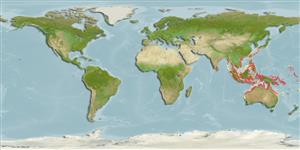Acrochordus granulatus (Schneider, 1799)
File snake| Native range | All suitable habitat | Point map | Year 2050 |

|
| This map was computer-generated and has not yet been reviewed. |
| Acrochordus granulatus AquaMaps Data sources: GBIF OBIS |
Google image |
No photo available for this species.
Classification / Names Common names | Synonyms | CoL | ITIS | WoRMS
Not assigned | Squamata | Acrochordidae
Environment: milieu / climate zone / depth range / distribution range Ecology
Benthopelagic; brackish; depth range 4 - 20 m (Ref. 2413). Tropical
Distribution Countries | FAO areas | Ecosystems | Occurrences | Introductions
Indo-West Pacific.
Length at first maturity / Size / Weight / Age
Maturity: Lm 58.0 range ? - ? cm Max length : 81.0 cm SVL male/unsexed; (Ref. 2413)
Short description Morphology
Life cycle and mating behavior Maturity | Reproduction | Spawning | Eggs | Fecundity | Larvae
Main reference
References | Coordinator | Collaborators
Wangkulangkul, S., K. Thirakhupt and H.K. Voris 2005 Sexual size dimorphism and reproductive cycle of the little file snake Acrochordus granulatus in Phangnga Bay, Thailand. Science Asia 31:257-263. (Ref. 2413)
IUCN Red List Status
(Ref. 130435: Version 2025-1)
CITES status (Ref. 108899)
CMS (Ref. 116361)
Threat to humans
Human uses
Fisheries: of no interest
| FishSource |
Tools
More information
Max. ages / sizes
Length-weight rel.
Length-length rel.
Length-frequencies
Mass conversion
Abundance
Internet sources
BHL | BOLD Systems | CISTI | DiscoverLife | FAO(Publication : search) | Fishipedia | GenBank (genome, nucleotide) | GloBI | Gomexsi | Google Books | Google Scholar | Google | PubMed | Tree of Life | Wikipedia (Go, Search) | Zoological Record


